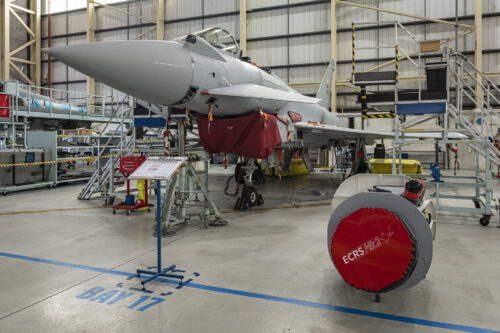The Royal Air Force (RAF) has reached a significant milestone in enhancing its Typhoon fleet’s capabilities with the successful first flight test of the European Common Radar System Mark 2 (ECRS Mk2). This cutting-edge radar, developed by Leonardo UK, was tested on a Typhoon test and evaluation aircraft at BAE Systems in Lancashire, marking a crucial step in the programme’s development.
The ECRS Mk2 represents a significant leap forward in radar technology, offering a unique blend of traditional radar functionalities and advanced electronic warfare capabilities. This makes it a formidable asset in the increasingly complex and contested airspace, equipping the Typhoon fleet for modern warfare scenarios.
Air Commodore Nick Lowe, Head Capability Delivery Combat Air and Typhoon Senior Responsible Officer at the Royal Air Force, highlighted the importance of this achievement, stating, “Evolution of Typhoon’s air combat capability is paramount to ensure Typhoon continues to deter potential aggressors, defend our nation and defeat our adversaries wherever we need to fly and fight whether for the UK or in our staunch support to the NATO alliance. This first flight of this ECRS Mk2 prototype new radar in the test aircraft is a positive step towards ensuring this.”
The ECRS Mk2’s advanced features are set to significantly bolster the RAF’s operational effectiveness. These enhancements include:
- Enhanced Traditional Radar Functions: The ECRS Mk2 offers significant improvements in search and targeting capabilities compared to earlier radar systems.
- Advanced Electronic Warfare Capabilities: The radar enables Typhoon aircraft to locate, identify, and suppress enemy air defences, greatly improving their survivability and effectiveness in hostile environments.
- Electronic Jamming Attack: The ECRS Mk2 allows Typhoons to disrupt enemy radar systems by jamming their signals while staying outside the range of enemy threats.
- Simultaneous Multi-Function Operation: The radar can simultaneously perform air-to-air, air-to-ground, and electronic warfare functions, demonstrating its adaptability in various combat situations.
- Extended Range Missile Guidance: The ECRS Mk2 provides extended-range missile guidance, enhancing the effectiveness and precision of long-range engagements.
- Large, High-Power AESA Aperture: This feature allows for greater sensitivity in detecting and tracking targets.
- Rotating Re-positioner for Maximum Power Positioning: This mechanism ensures optimal radar power is directed across the system’s field of regard.
- Wide Field of Regard (50% Greater Than Traditional Fixed AESA): This provides a wider coverage area for detecting and engaging targets.
- Wideband Electronic Attack Capabilities: The system can jam a broader range of enemy radar frequencies.
- Enhanced Multi-Channel Receiver and Processor: This allows for improved signal processing and target identification.
- High Availability due to Graceful Degradation and Increased Redundancy: The system is designed to maintain functionality even with some component failures, increasing its reliability.
This development programme is of significant strategic importance to the UK and its commitment to the NATO alliance. Equipping the RAF with such advanced technology ensures the UK remains at the forefront of air power and capable of defending its interests and deterring potential adversaries. As Nick Moore, Typhoon Deputy Head Capability Acquisition at DE&S, emphasized, “This is another landmark moment in this strategically important programme which will provide the RAF with battle-winning technology that gives them the edge to protect the nation. The ECRS Mk2 radar will further transform Eurofighter Typhoon’s control of the air and provide exceptional capability our adversaries will struggle to match.”
The ECRS Mk2 is scheduled to enter service with the RAF’s Typhoon fleet towards the end of the decade. It boasts compatibility with Tranche 2, Tranche 3, and future tranches of the Eurofighter Typhoon, and importantly, can be retrofitted to existing Tranche 2 and 3 aircraft, ensuring a smooth transition and extended operational life for the fleet.
Beyond its military significance, the ECRS Mk2 programme is bolstering the UK’s combat air industry, supporting 600 highly skilled jobs nationwide. Andy Holden, Radar Delivery Director at BAE Systems, highlighted this, stating, “The development of Typhoon’s radar supports 600 jobs across the UK’s combat air industry. Programmes such as the ECRS Mk2 ensure the UK retains a sovereign capability to develop and integrate cutting edge systems into frontline combat aircraft such as Typhoon. Through this work we are directly supporting critical know-how and sustaining hundreds of highly-skilled jobs.” Leonardo’s site in Edinburgh is a significant beneficiary, securing over 300 jobs, with an additional 100 in Luton and 120 at BAE Systems in Lancashire.
Tim Bungey, Chief Engineer for ECRS Mk2 at Leonardo UK, emphasized the programme’s commitment to British engineering excellence, stating, “In parallel with the trials, the radar’s production design has also been progressing apace. The development of the ECRS Mk2 is fully using the UK’s world-class radar design skills. Over the past few months, its processor, receiver and antenna power supply and control units have all been re-engineered from the prototype design to further enhance the capacity, capability and performance of the Mk2 system in alignment with the new antenna and electronic warfare capability.”
For more information, hit the Source below
